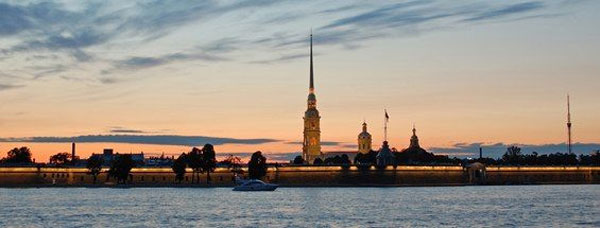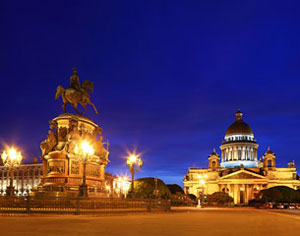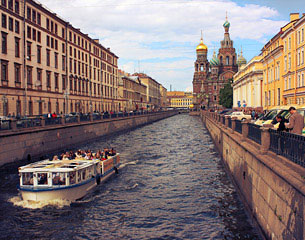Reply To:
Name - Reply Comment

Founded in 1703 by Peter the Great, Russia’s former capital is built where the river Neva joins the Gulf of Finland. Spread over more than 40 islands, St. Petersburg is often referred to as ‘Venice of the North’ thanks to its network of canals and rivers. Criss-crossed by many impressive bridges and lined with imposing buildings from two centuries ago, a boat trip around these waterways is highly recommended.
 Having survived a long and turbulent history, modern St. Petersburg is now better known for its cultural heritage. Filled with impressive 18th and 19th century architecture, this one-time capital of Russia is home to some of the best ballet, opera and classical music in the world.
Having survived a long and turbulent history, modern St. Petersburg is now better known for its cultural heritage. Filled with impressive 18th and 19th century architecture, this one-time capital of Russia is home to some of the best ballet, opera and classical music in the world.
When looking for the best time to visit, every season in St. Petersburg brings out something unique in the city. Winter offers the spectacular sight of the frozen Neva and Spring sees the city come back to life as the snows thaw. But a particular favourite of locals are the festivities that take place during the White Nights of June, when the sun hardly sets and daylight never quite disappears.
Dining in St. Petersburg
Over recent years, restaurants in St. Petersburg have changed for the better and are now much closer to the standards of other European tourist cities. No single area can lay claim to having the best places to eat and quality restaurants are spread out across the city.
Food is primarily European cuisine, although many places include traditional Russian dishes on their menus. Look out for Zakusi, a selection of hors d’oeuvre that often include pickled vegetables, cured meats and fishes, salads and breads. Borshch is another popular staple, a beetroot-based sweet and sour dish served cold in summer and hot in winter. And the ever-popular Russian caviar is always worth a try.
Exploring St. Petersburg
 A good place to start your visit is at the beginning. After defeating the occupying Swedish forces in 1703, Peter the Great built the Peter and Paul Fortress to protect his newly conquered lands. The fortress became the birthplace of St. Petersburg.
A good place to start your visit is at the beginning. After defeating the occupying Swedish forces in 1703, Peter the Great built the Peter and Paul Fortress to protect his newly conquered lands. The fortress became the birthplace of St. Petersburg.
The original wooden structure was eventually replaced with stone by the Swiss-Italian architect Domenico Trezzini, who went on to design several of St. Petersburg’s iconic buildings.
Underneath its impressive exterior, the fortress has a gruesome history. Many political prisoners were held and tortured there, including Peter’s own son Alexis. Today the cells are open to the public and you can find a small exhibition of period photographs, prison uniforms and a model of the guardroom on the ground floor. Also within the fortress are several museums of local history and the impressive Peter and Paul Cathedral, which houses the tombs of the Romanovs.
Flights to St. Petersburg, Russia
Almost directly opposite the fortress, on the other side of the Neva, you’ll find the Hermitage museum. One of the most famous museums in the world, the Hermitage is St. Petersburg’s most popular attractions and sees more than 2.5million visitors a year.
With over 350 rooms of exhibits, taking a guided tour is a good way to see the highlights, as well as being the only way to get inside the Treasure Galleries. Star exhibits include The Return of the Prodigal Son by Rembrandt, Gauguin’s Ea Haere Ia Oe and La Danse by Matisse.
Although the Hermitage houses many incredible collections, very few are from Russia. Luckily, the world’s finest collection of Russian art is housed nearby at the Russian Museum in Mikhailovskiy Palace where over 400,000 works offer an invaluable insight into the country’s artistic heritage.
A few hundred meters away, across the picturesque Mikhailovskiy Garden, is another of St. Petersburg’s most impressive landmarks. The Church of the Saviour on Blood is built on the spot where an assassin fatally wounded Alexander II on March 1, 1881. A riot of colour and juxtaposed materials, the church was re-opened in 1998 after more than twenty years of restoration.
Beyond St. Petersburg
Just outside St. Petersburg, on the Baltic shore, Peterhof Park is remarkable for the sheer variety of styles it encompasses. Covering 607 hectares (1,500 acres), this grand park represents nearly two centuries of aristocratic European fashion and has numerous palaces, fountains and sculptures to explore.
We would also recommended spending a day at the imperial palace of Tsarskoe Selo. Surrounded by incredible parks and gardens, an early arrival is a must to both fit everything in and beat the crowds. Visit the Catherine Palace and enjoy the splendour of the Amber Chamber, covered in intricately-carved amber panels.